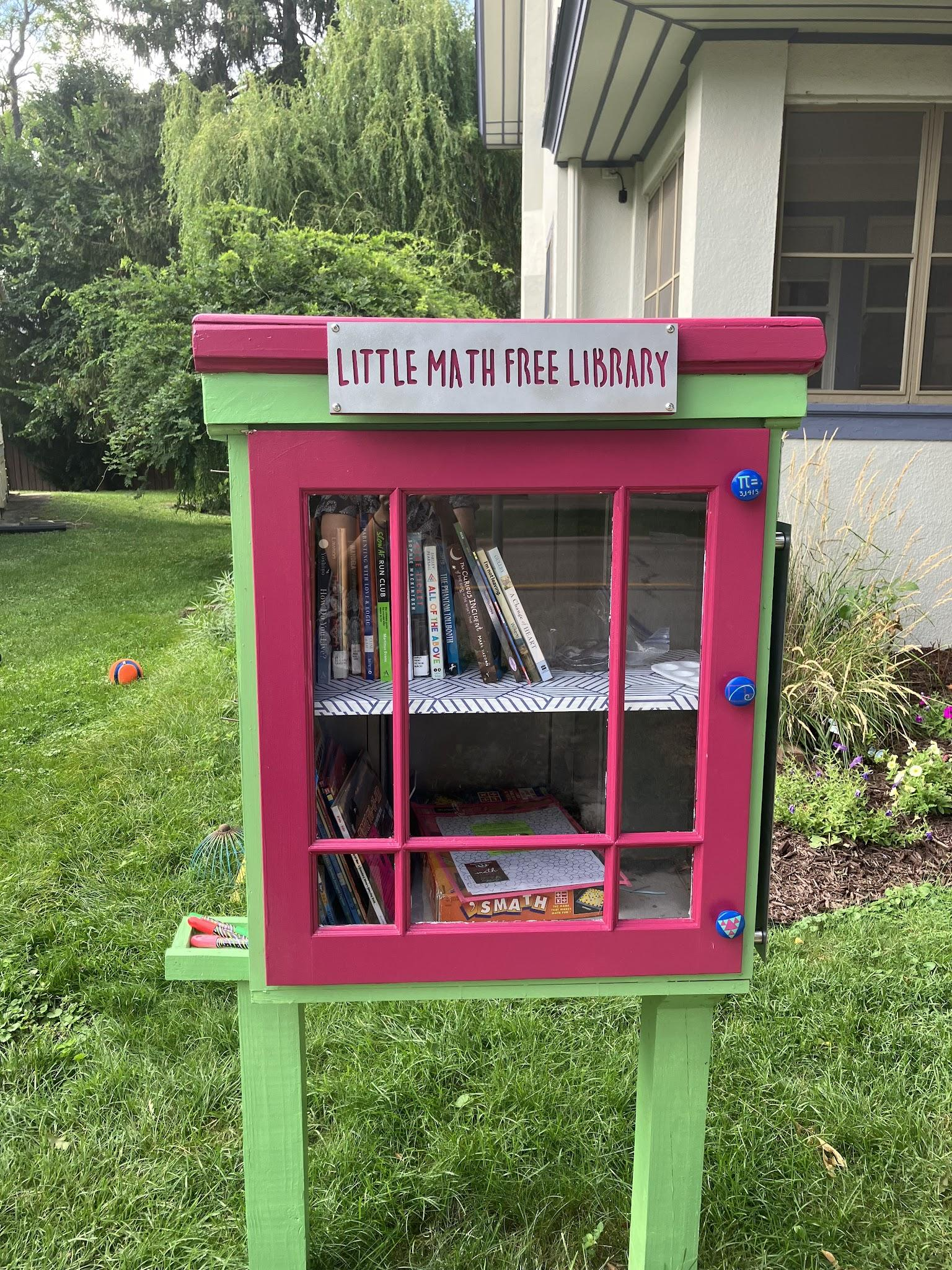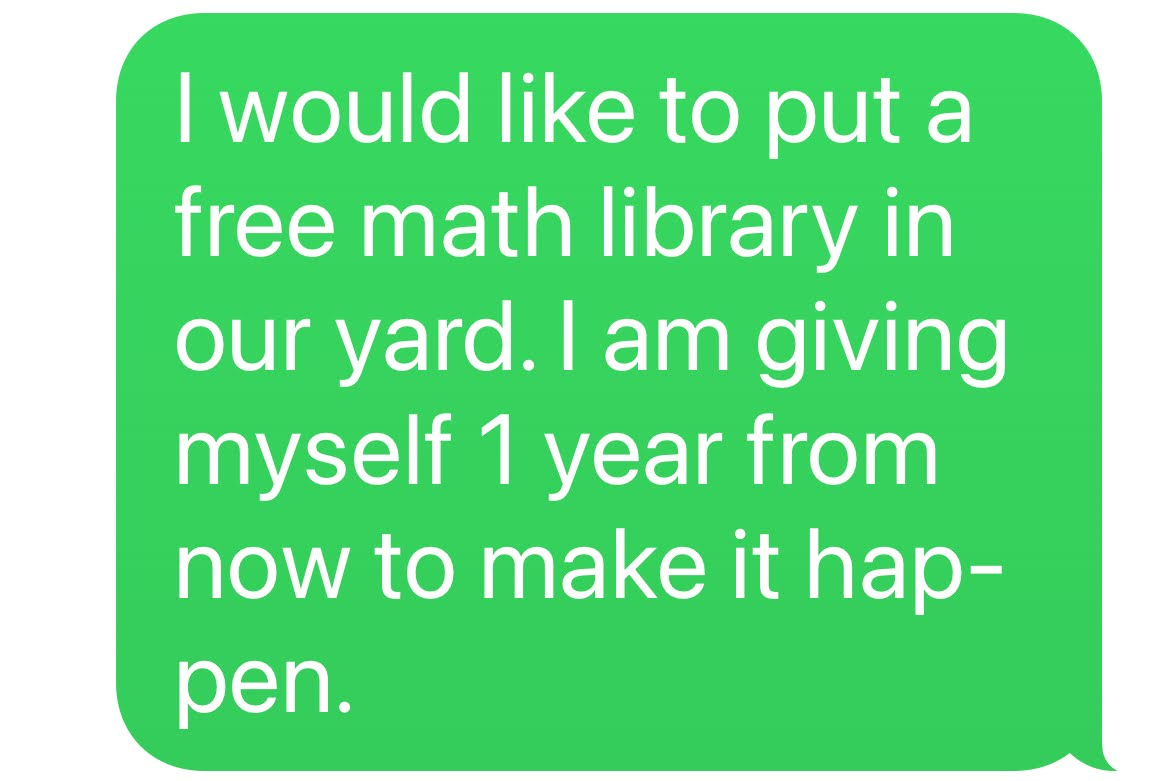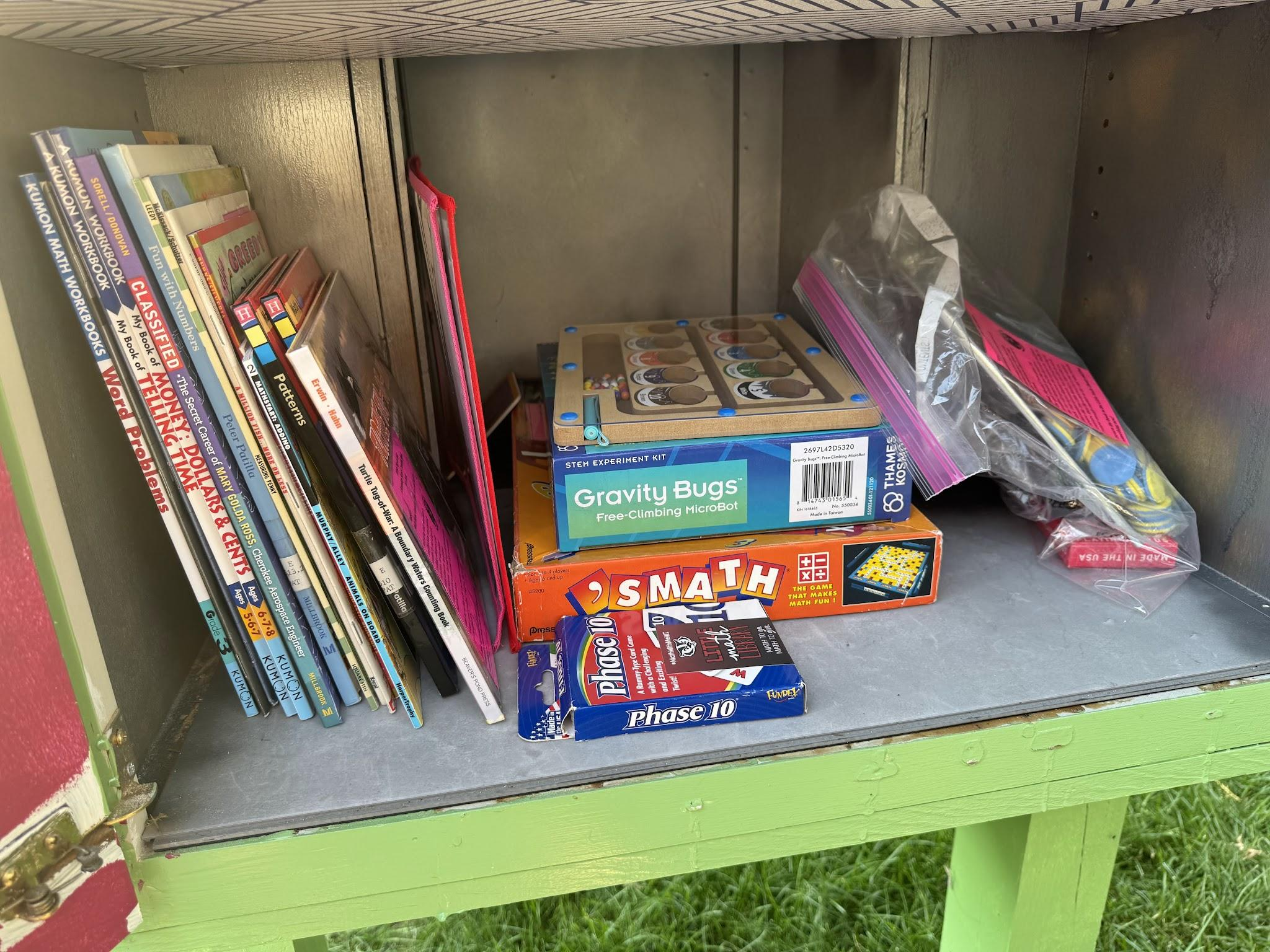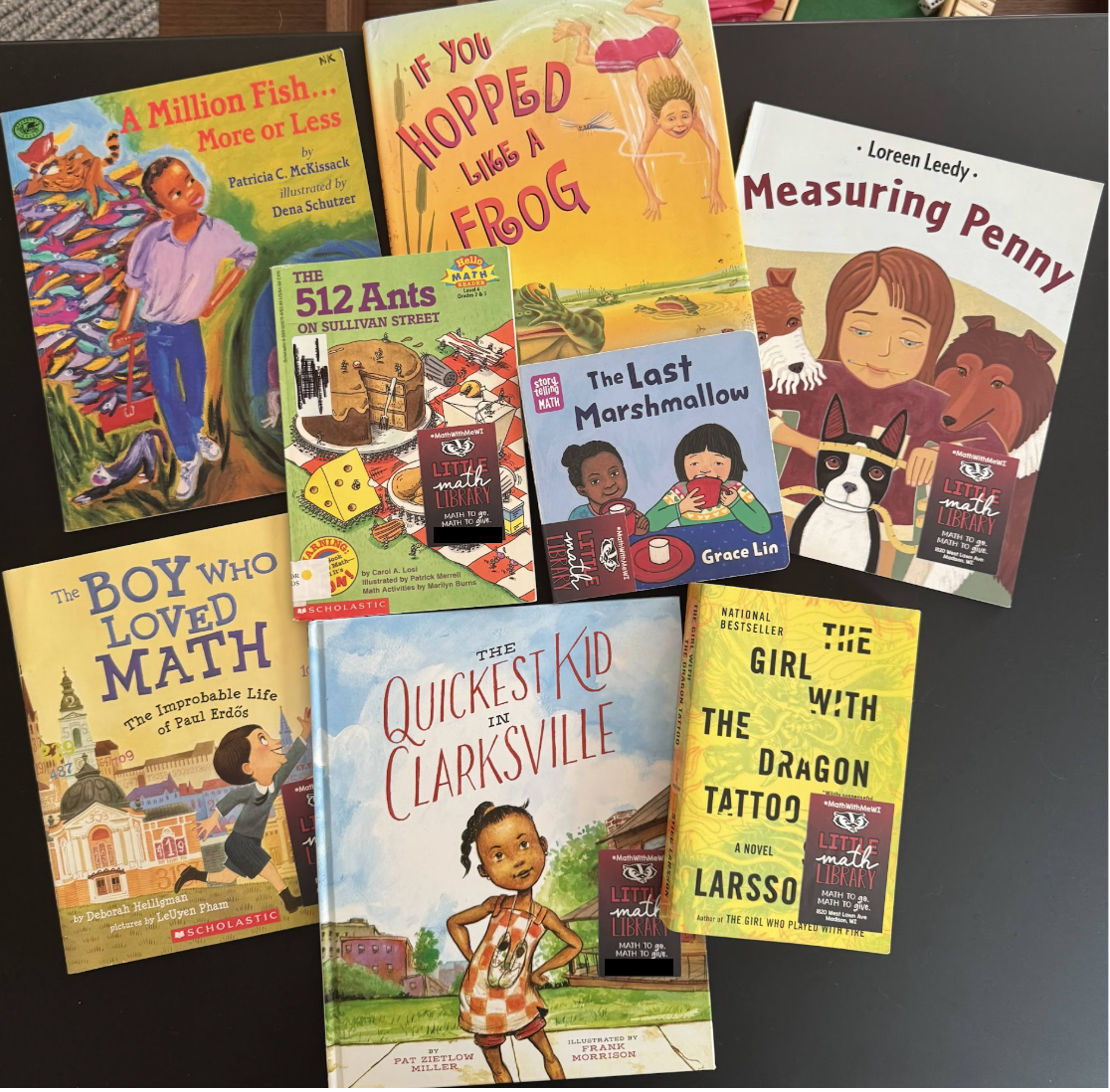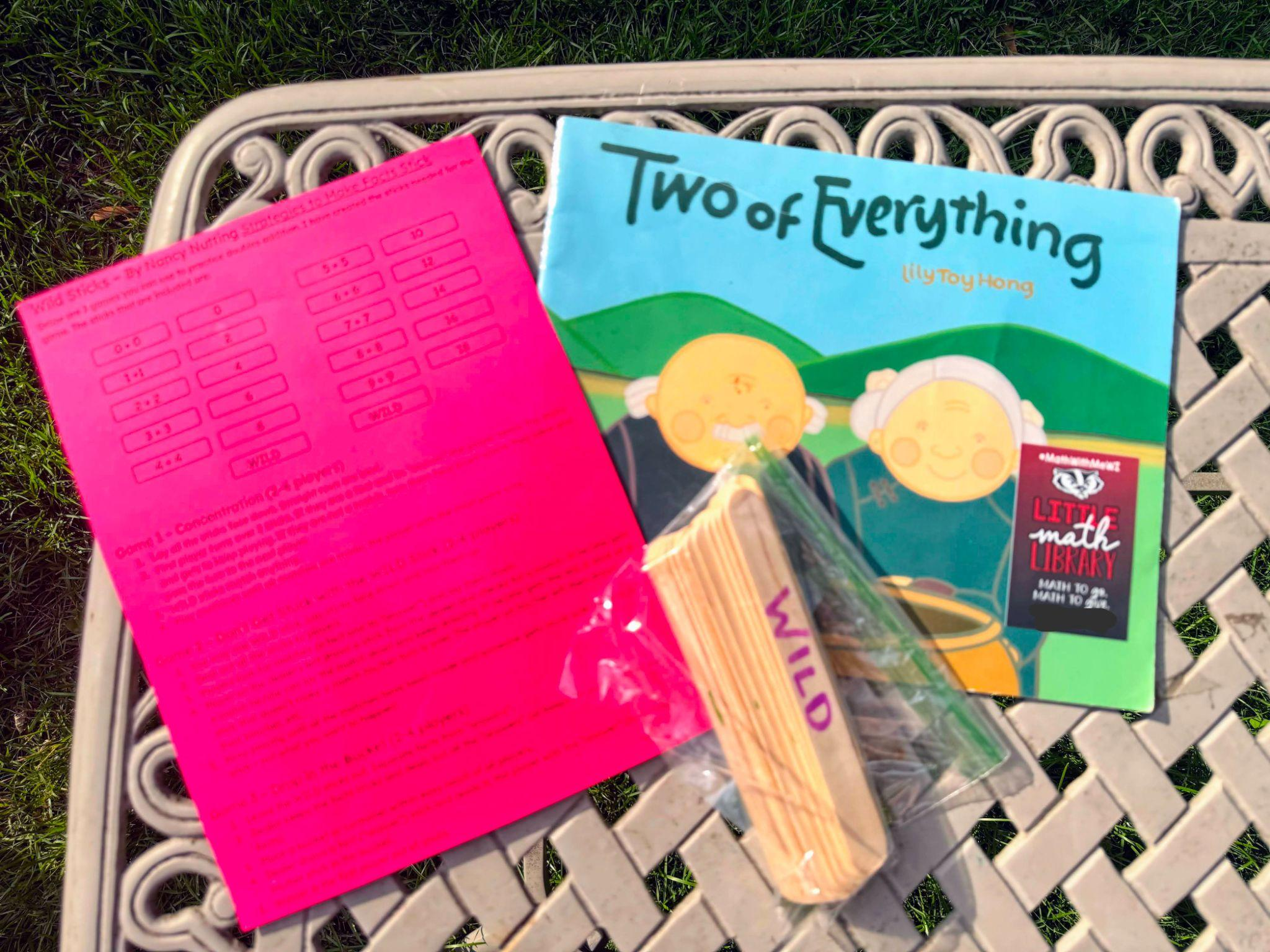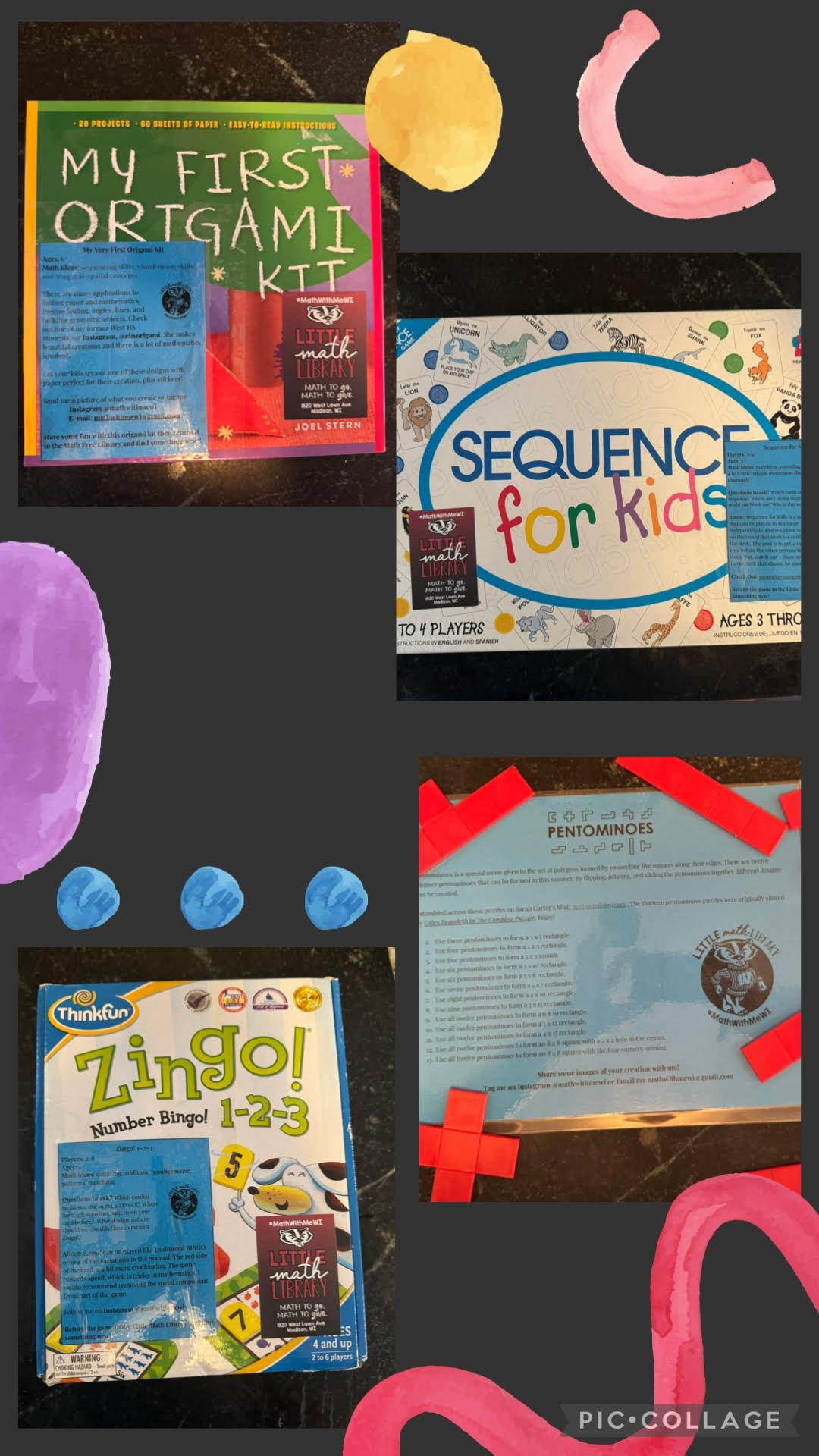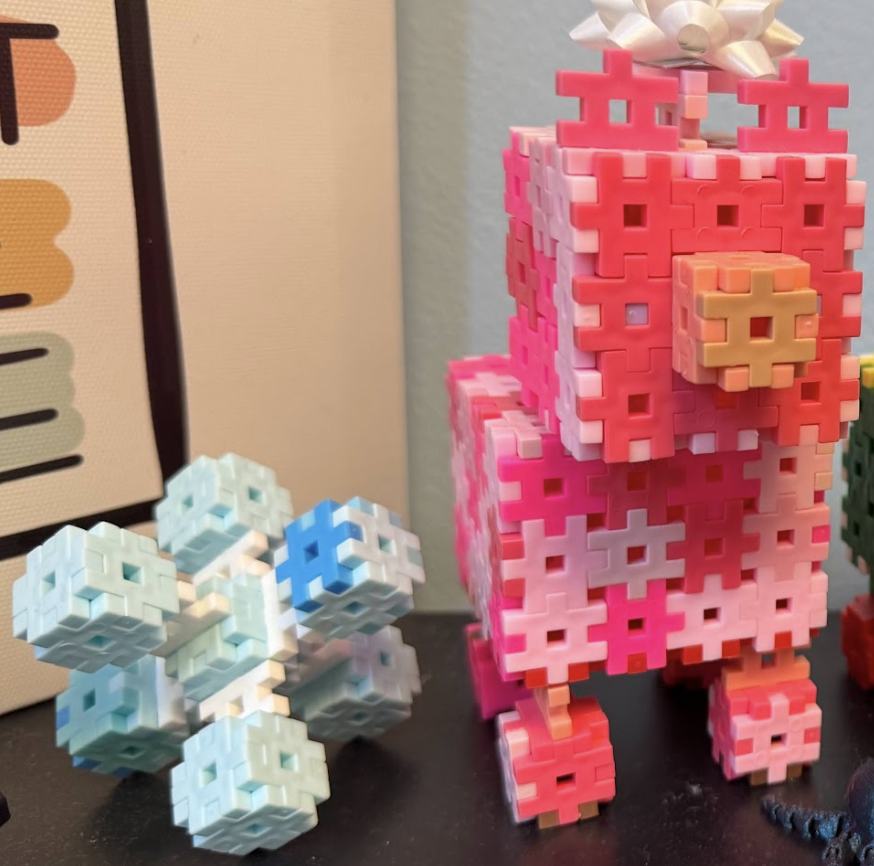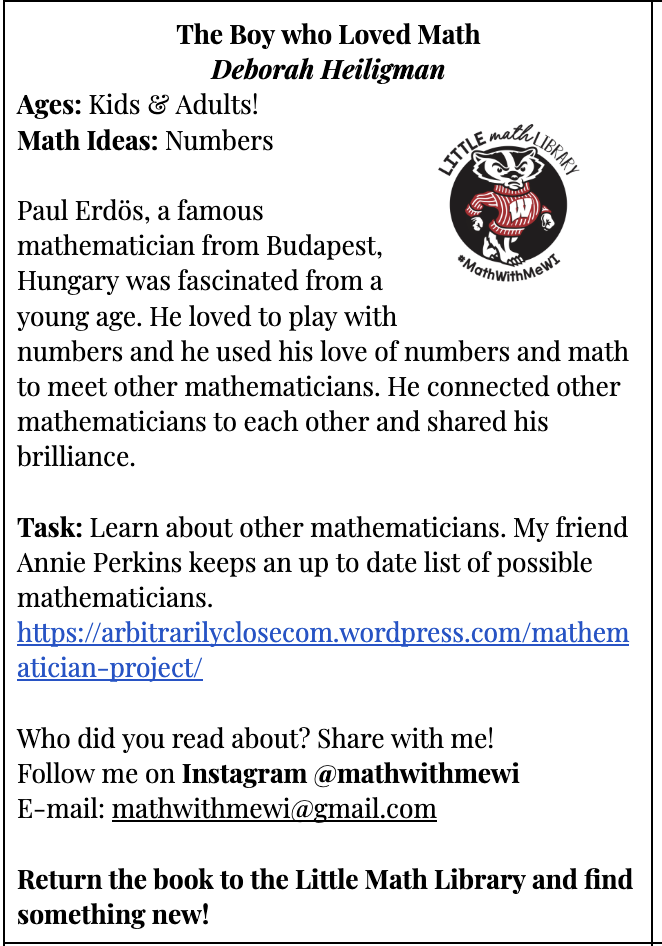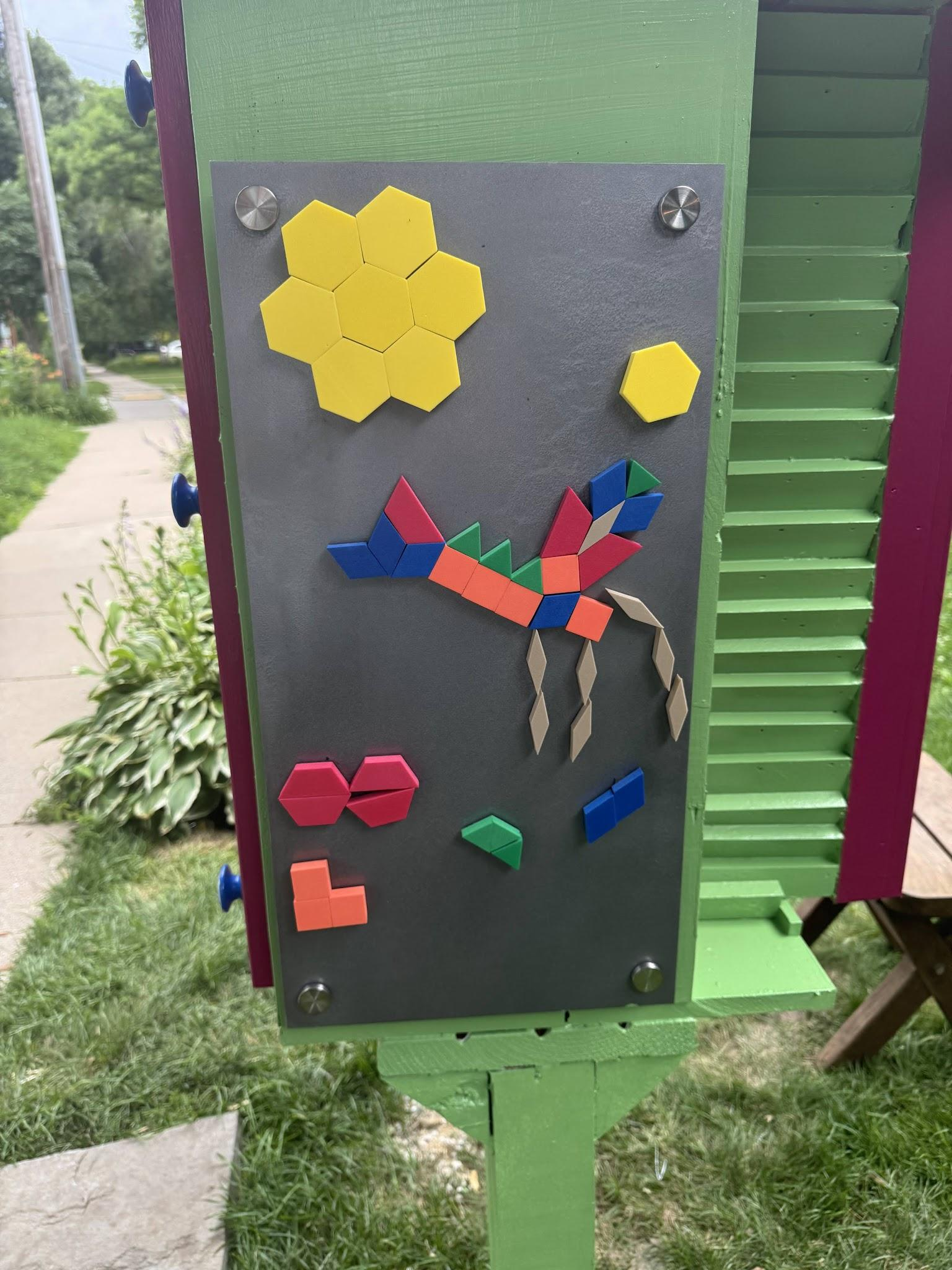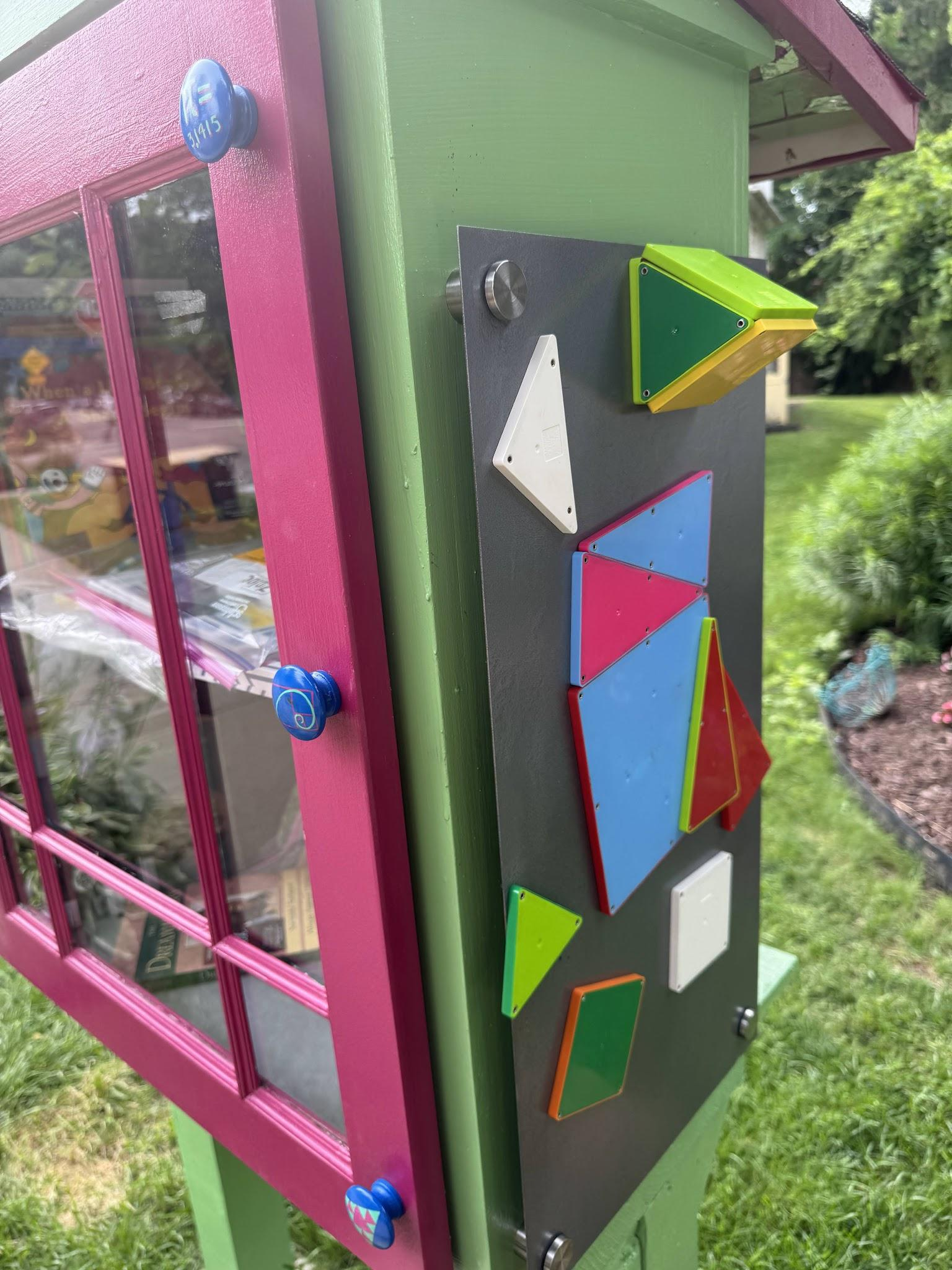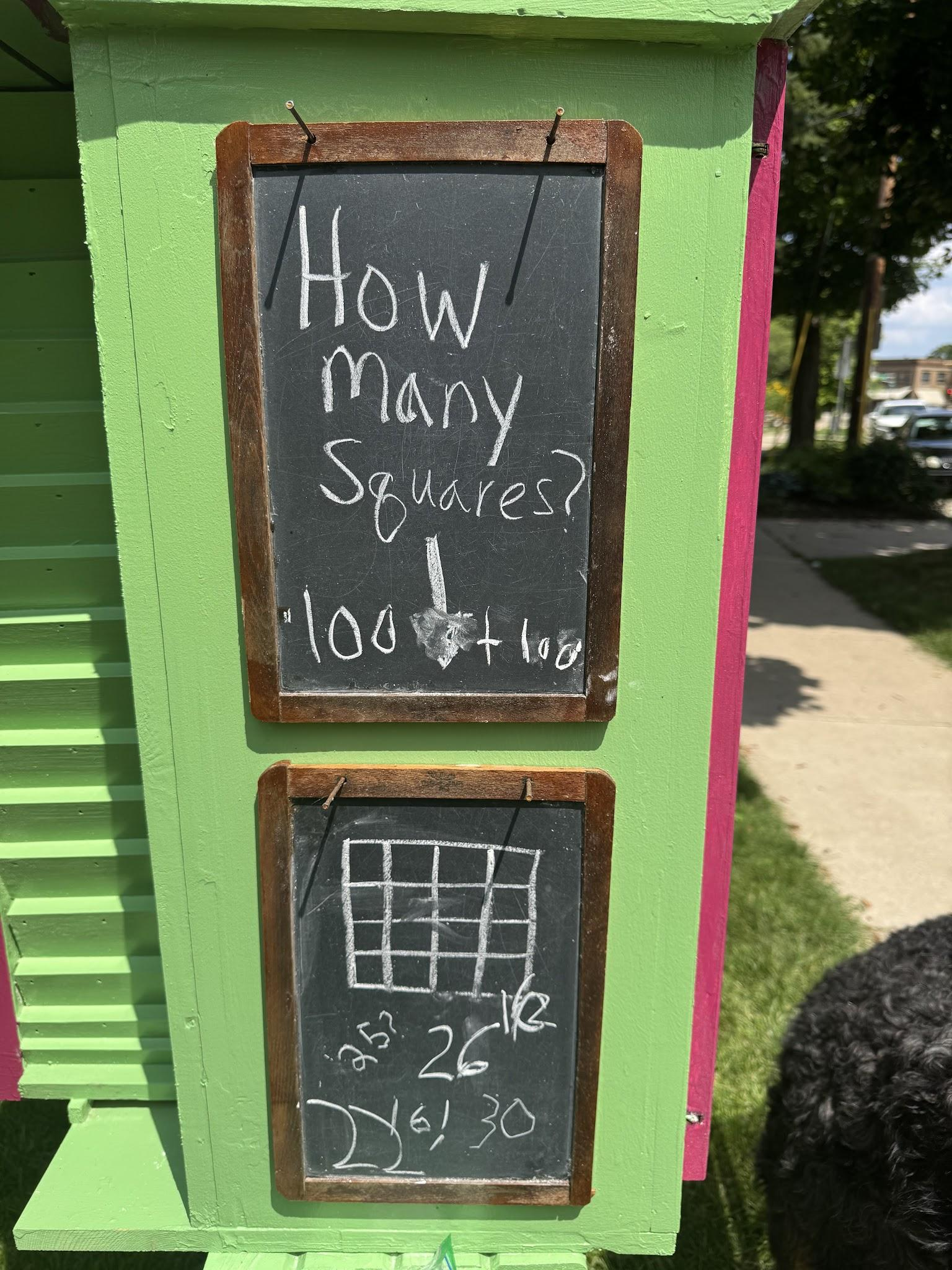August 2025
Welcome to EFM's August Newsletter!
Read, Count, Play – Every Child, Every Day!
It is essential that every caregiver in the world reads books and does math with their young children!
EFM believes in every child’s mathematical right to equity, opportunity, and personal fulfillment.
Guest Writer
This month’s newsletter is guest written by Jessica Breur, a math enthusiast, long-time math educator, and mom of Sylvia (10) and Oliver (12). Jess discovered Early Family Math in her quest to find accessible resources that she could share with families who were visiting her Little Math Free Library that she installed at her home in Madison, WI.
Welcome! – Little Math Free Libraries
Welcome to our Little Math Free Library! This took my family and me about 10 months to bring to fruition and while that may seem like a long time, it really isn’t since now we have something permanent that will be used by our community for as long as it is standing.
I started dreaming about this project in September of 2024. On September 28, 2024 I shared my idea with my husband and set a due date to get this done…1 year! I started slowly by logging ideas in a notebook. Then, I began organizing the mathy books, toys, and games that I owned that would be worth sharing in a math library. My kids joined in and helped by going through their board games and books. They also played new games with me to determine if they met the criteria – an underlying math theme and fun. Needless to say, we found one game that still hasn’t made it into the library because they love it so much…I just need to find a second copy!
Why build a Little Math Free Library?
Each month this newsletter starts with the following quote:
“It is essential that every caregiver in the world reads books and does math with their children.”
What if your response to that quote is, I was never good at math, or I don’t know how to teach math, or where do I start? My kids are getting older and I realize they have been privileged growing up with a parent who can seamlessly weave math as well as literacy into our activities and conversations on a daily basis. I also have a dear friend who shared this quote with me, “find what you love, and do more of it.” So, combining my love of mathematics with my aspiration to help every person see themselves as a mathematician prompted me to start engineering a product that would spread the joy of mathematics with people of all ages while equipping adults with small pieces of knowledge to help them have the same type of conversations with children, that I was having with mine. Thus the idea for a little math free library was born.
Getting started!
As mentioned above, I started dreaming in September. My goal was to fill the library with books, toys/manipulatives, and games that could be borrowed and ideally returned for others to enjoy. As with other free libraries, I hoped that once people visited they would get the idea of the math theme and would also donate the same types of items so the library would become community funded. Now that the library is up, neighbors have started sharing mathy books they have in their home!
In March and April I started researching different designs for the structure and sending them to my husband who graciously agreed to help me build the library. I knew my structure had to be bigger if it was going to include space for board games. I also wanted shelves: one for books, one for games, and one for toys. I have since learned that items for our youngest learners have to go on the bottom shelf. They want to see and touch the stuff! Eventually, we found a used cabinet that my husband felt like he could modify and he got to work in May. While he worked away on the structure, I set my sights on filling the library.
Books.
The very first mathy book I was given when I started teaching was, The Math Curse by Jon Scieszka and Lane Smith. I loved this book. It showed how math could be applied to everyday occurrences. I read this book aloud to my 8th grade students and as an end of the year project they all added a new page to the book. The students were so creative and this project allowed me to more fully recognize their mathematical brilliance.
When my own kids were little one of their favorite books was, Count the Monkeys by Mac Burnett and Kevin Cornell. They loved the uniquely dressed monkeys, the silly passages, and telling me how many they saw. All the while, they never realized this book was introducing counting forwards and the concept of zero!
Books like The Math Curse and Count the Monkeys were what I desired to put in my library. The next step I took was to start inventorying the books I had and start thrifting to find more books. I reached out to colleagues and friends who shared book ideas with me. Shout out to Melynee Naegele who shared her entire list with me! I also found many websites such as Maths Through Stories that gave me ideas of books to look for and I searched blogs to find books that were geared towards older students and adults. Right now, the list of books I own plus others I am searching for is well over 400! It was important to me to make sure I had books that would appeal to all ages, so I have categorized my list by age group and math topics. Don’t let the large number of books scare you away! I started my library with about 60 books and I only put about 10-15 books in the library at a time.
What else besides books?
Games! Over the years our kids have enjoyed many games. Examples include learning about doubles by playing Candy Land, representing quantity by playing Tiny Polka Dot, directional words and recognizing 4 in a row by playing Connect 4, ordering numbers by playing Rack-O, multiples by playing Yahtzee, and spatial awareness by playing Blokus. Guess what, my kids never knew they were learning math concepts while playing! The best resource for learning about games that can be purchased to support mathematical learning is from Kent Haines’ blog, Games for Young Minds. I had some games in our cabinets that we had outgrown, but not nearly enough. I again started thrifting which helped me build out my game library for a very small amount of money. There are also many card games, games with dice, or games with popsicle sticks that are great to play as a family. The first one I remember my kids bringing home was “Make 10 Go Fish.” This was an easy adaptation to the original Go Fish game and we played with a typical deck of cards. Due to the ease of games like this, sometimes I also pair a simple game with a book.
Mathy Toys
Mathy toys? Of course! Think of some of your earliest toys, did you have the iconic shape sorter? Wooden blocks? Puzzles? A toy clock? All of these toys and more have mathematical attributes. I frequently tell teachers I work with that students should be able to “play with the math.” They should be able to visualize it, manipulate it, create and build. We can foster a sense of curiosity and play when we put these types of toys in students' hands. I love Magnatiles, Hashtag Blocks, Pattern Blocks and so much more. Sara Van Der Werf, first turned me on to having these types of “toys” in my classroom through her blog. Now, I don’t need a classroom, I can pack up toys into an old pencil box and put it in the library for people to explore with!
Supporting Parents
Putting books, games, and toys into my library was not going to be enough. I wanted to help parents know potential questions to ask, follow-up games to play, or where to go for more learning. I started to create specific cards for many of the resources. This is a work in progress. I usually create the cards when I put more items in the library. These cards get laminated and then affixed to the book, game, or toy. I always invite readers to share something back with me either through email or Instagram (I created unique accounts for this project). While I haven’t had any takers yet, it has only been 2 months since I started my library. I also request that everything gets returned to the library so another person can have the same experience and so the original person can find something new. Guess what, things have started to come back! It will take a bit of time and not everything will be returned, but some of it will! I also always secretly hope that some items from my library get dropped in a different free library!
Small details
Everything that goes into my library gets tagged with a sticker. I created a hashtag (#mathwithmewi), email address and instagram account to celebrate what was happening with the library. Since I wanted items to be returned, I added the address of the library on the sticker as well. Since stickers can be removed, I may consider converting the sticker to a stamp.
Keep your eyes open! I probably add new items to my library at least once a week. This is a combination of games, books, and toys. I have found lots of additional items at thrift stores, but stopping at neighborhood garage sales, watching Buy Nothing groups, library sales, and donations from folks retiring has been the biggest help. This past week I found a book by Simon Singh called The Simpsons and Their Mathematical Secrets at a garage sale for $0.25! I am so excited to read it first and then put it in the library. Also, don’t be afraid to ask for donations. I have found people are excited to negotiate on price or donate when they understand how the items will be used. Finally, people will put non-math related items in your Math Library. For now, I have made the decision to not remove items that don’t follow the math theme.
Make it uniquely yours! I truly miss having a student experience every day. Thus I wanted my library to be interactive. Most of my ideas for making the library interactive come from my colleague Christopher Danielson who, among other things, created Math On a Stick at the Minnesota State Fair and blogs at Talking Math with Your Kids. I had the opportunity to volunteer at Math On a Stick for many summers and watching the experience of those who stopped by was awe-inspiring. On one side of my library visitors will find 2 slate chalkboards from the 1800’s where I pose a question and seek responses. On the other side of the library I have a magnetic board where visitors can interact with different puzzles or math manipulatives to be creative.
Besides the interactive sides, my other favorite part of the library is the custom door pulls that someone painted for me. I didn’t need 3 door pulls, but I love the colors of them and they make me excited every time I see them.
Why build a Little Math Free Library?
I have been blessed in my career to learn with and from the best. I frequently remind myself that I am standing on the shoulders of giants, some of whom I referenced in this newsletter. Building the Little Math Free Library has allowed me to give back to my community and share my passion in a unique way. It also allows me to continue learning and stay curious. Our children are brilliant and they have so much to share with us, we just need to ask!
If you are interested in building your own Little Math Free Library, please do not hesitate to get in touch with me. Or, if you want to start smaller and just add “mathy things” to someone else’s Free Library that works too. The goal is and has always been spreading mathematical joy with others.
If you have any questions or comments, please send them to either one of us! We would enjoy the opportunity to chat with you. Also, if you are interested in collaborating with us or supporting us in any fashion, we would love to talk with you about ways we can work together!
August 18, 2025
Jessica Breur (aka Jess Math Lady) MathWithMeWI@gmail.com
Chris Wright
Chris@EarlyFamilyMath.org
Twitter | Facebook | Instagram
Early Family Math is a California 501(c)(3) nonprofit corporation, #87-4441486.

